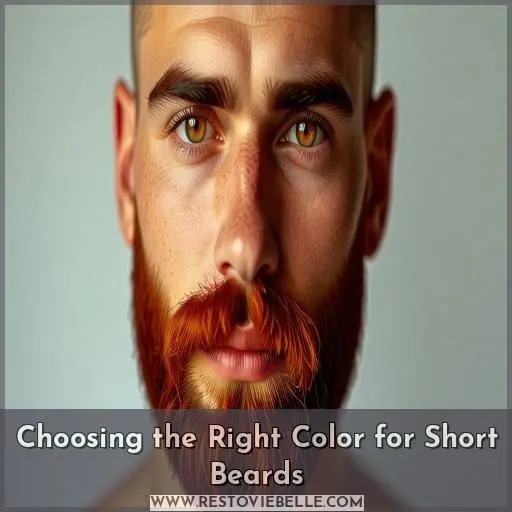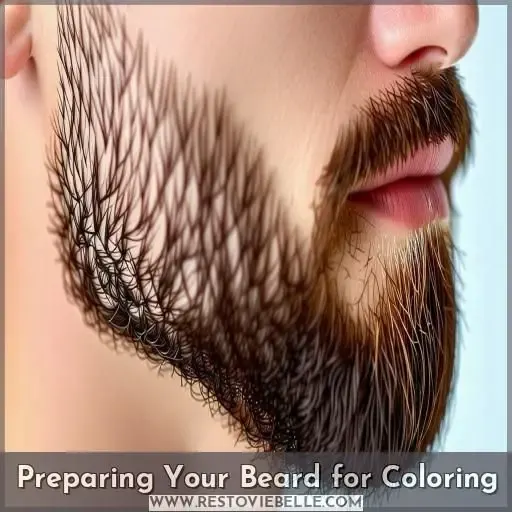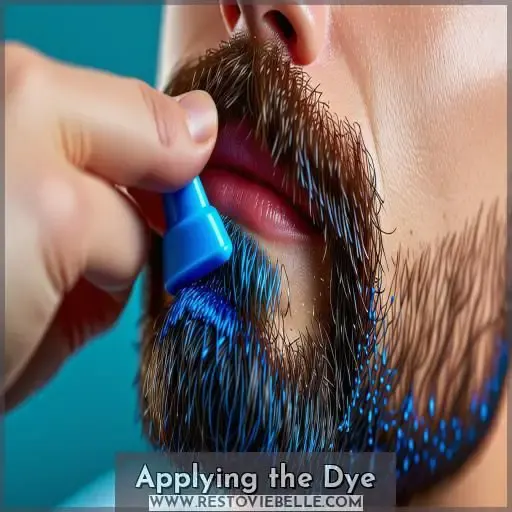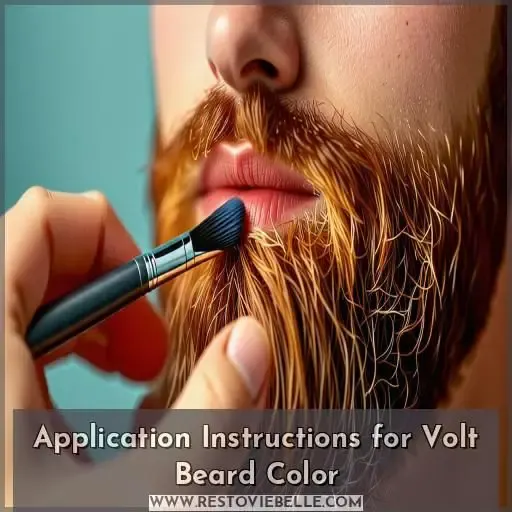This site is supported by our readers. We may earn a commission, at no cost to you, if you purchase through links.
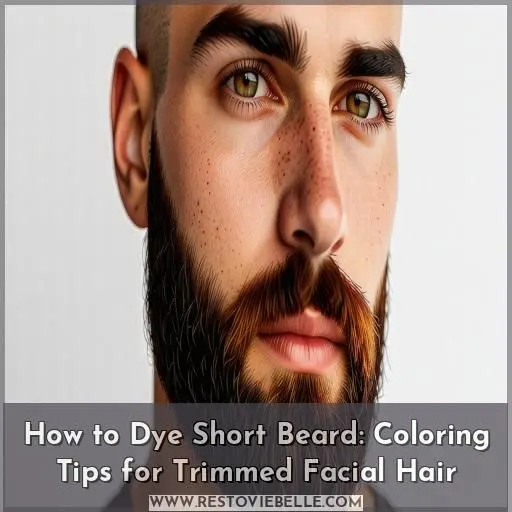
Start by choosing a dye shade that matches or complements your natural hair color.
Wash your beard thoroughly, apply a barrier cream around the edges, and do a patch test.
When applying the dye, use an applicator brush and feather in short strokes, focusing on grays first.
Leave it on for the recommended time, then rinse.
Volt Beard Color is ideal for short beards – it’s hypoallergenic, applies directly to skin, and its precise brush allows customized color blending for a natural look.
Table Of Contents
- Key Takeaways
- How to Dye Short Beard?
- Choosing the Right Color for Short Beards
- Preparing Your Beard for Coloring
- Applying the Dye
- Benefits of Volt Beard Color for Short Beards
- Application Instructions for Volt Beard Color
- Frequently Asked Questions (FAQs)
- Can you dye your beard when its short?
- Can you color a stubble beard?
- What is the best dye for stubble?
- At what length can you dye your beard?
- How long does beard dye last on short beards?
- Can I dye my beard if I have sensitive skin?
- How often should I reapply beard dye?
- Can I use regular hair dye on my beard?
- Will beard dye damage my beard hair?
- Conclusion
Key Takeaways
- Choose a dye shade that matches or complements your natural hair color
- Prepare your beard by washing it thoroughly and applying a protective barrier around the edges
- Consider the goals and objectives of dyeing your short beard, whether to cover grays evenly or achieve a uniform color
- Opt for hypoallergenic and chemical-free beard dye options like Volt Beard Color for a customizable, mess-free application
How to Dye Short Beard?
To dye a short beard, first choose the right color that matches your goals and natural beard shade.
Then, prepare your beard by washing it, applying protective products, mixing the dye, and conducting a patch test.
Apply the dye using an applicator brush, focusing on gray or patchy areas, and wait for the desired shade before washing it out.
For a mess-free application and natural-looking results, consider using a hypoallergenic and chemical-free beard color like Volt, which can be directly applied to the skin.
Choosing the Right Color for Short Beards
Before coloring your short beard, determine your goals – whether to cover grays evenly or achieve a uniform color. Match the shade closely to your natural beard color, considering dye types like permanent, semi-permanent, or temporary options and choosing lighter shades for long-lasting dyes and darker ones for temporary colorants.
Determining Goals
Before dyeing your short beard, determine your goals. Do you want to:
- Cover gray hair?
- Achieve a uniform color?
- Match your hair color?
- Experiment with a new shade?
Clarify your objectives to select the right beard dye.
Matching Shade to Beard Color
To achieve a natural-looking beard color, choose a shade slightly lighter than your natural hair color. Customize the color to your liking and prevent skin irritation by selecting a dye that preserves your beard’s natural hue.
- Opt for a lighter shade
- Match color to natural hair
- Customize to your preference
- Avoid skin irritation
- Preserve natural beard color
Considering Dye Type
When coloring your short beard, consider the type of dye:
- Permanent: Long-lasting, requires touch-ups
- Semi-permanent: Similar to permanent, but fades faster
- Temporary: Washes out easily, ideal for sensitive skin
Choosing the Right Dye
When choosing the right dye for your short beard, consider the following:
- Opt for permanent dyes for long-lasting results.
- Select darker shades for temporary dyes.
- Prioritize ammonia-free dyes for sensitive skin.
Preparing Your Beard for Coloring
Before applying beard dye, wash your facial hair thoroughly with a mild cleanser to remove any dirt, oil, or product buildup. Next, apply a protective barrier like petroleum jelly or beard oil around the edges of your beard to prevent the dye from staining your skin.
Washing the Beard
Wash your beard with a gentle beard cleanser to remove dirt, oil, and product buildup. Rinse thoroughly and pat dry with a clean towel. Avoid using regular shampoo, as it can strip natural oils and cause irritation.
- Use lukewarm water to wet your beard
- Apply a small amount of beard wash
- Massage the wash into your beard and skin
- Rinse thoroughly to remove all traces of the wash
Applying Protective Products
Before coloring your short beard, apply a thin layer of Vaseline or beard oil around the edges to prevent skin irritation and staining. This protective step is essential for sensitive skin types. Avoid getting dye on the skin for best results.
- Apply Vaseline or beard oil around the beard line to prevent skin irritation and staining.
- Vaseline creates a protective barrier between the skin and the dye.
- Beard oil nourishes and conditions the skin while providing a barrier.
- Sensitive skin types should take extra precautions to avoid irritation from harsh dye chemicals.
Mixing the Dye
Mix the dye according to the instructions, using equal parts color and developer. Wear gloves and work in a well-ventilated area. Perform a patch test on a small area to check for irritation and desired color before full application.
Conducting a Patch Test
Before applying beard dye, conduct a patch test to check for skin sensitivity and dye allergies. Apply a small amount of dye to your inner arm, wait 24 hours, and check for irritation. Consider natural alternatives if you experience any adverse reactions(Source).
Applying the Dye
To apply the dye, use an applicator brush and focus on covering any gray or patchy areas first. Once those areas are coated, let the dye sit for the recommended time to achieve your desired shade, typically 5-10 minutes, before rinsing thoroughly with water and beard shampoo.
Using an Applicator Brush
Once your beard is prepped, use an applicator brush to apply the dye evenly. Here are some tips:
- Use a small, angled brush for precision
- Dip the brush lightly into the dye
- Apply in short, feathery strokes
- Blend outwards from the center
- Touch up any missed spots
Focusing on Gray or Patchy Areas
Focus on graying or patchy areas first. This allows the dye to work longer there, ensuring full coverage. Apply dye with:
- Precision
- Patience
- Attention to detail
- Customized application
Proper preparation and targeted application create a natural, even result.
Waiting for the Desired Shade
After focusing on the grays, let the dye sit for the recommended time. Adjust the wait time based on:
- Desired intensity
- Personal preference
- Color swatches provided
Varying the wait allows you to achieve your ideal shade.
Washing Out the Dye
After letting the dye sit for the recommended time, thoroughly rinse your beard with lukewarm water. Gently massage in a sulfate-free beard shampoo, then rinse clean. Pat dry with a soft towel and apply a nourishing beard oil or balm to condition your freshly dyed facial hair.
- Use lukewarm water for rinsing to avoid irritation
- Choose a gentle, sulfate-free beard shampoo for washing
- Gently massage the shampoo into your beard for a deep clean
- Pat dry with a soft towel to avoid damaging the hair
- Apply a beard oil or balm to condition and style your dyed beard
Benefits of Volt Beard Color for Short Beards
If you’re looking to dye your short beard, Volt Beard Color offers a hypoallergenic and chemical-free option that allows for direct application on the skin.
Ensuring a customizable, mess-free process that blends seamlessly for natural-looking results.
With its unique formulation, Volt Beard Color provides a safer alternative to traditional beard dyes.
Enabling you to achieve your desired shade without harsh irritants or additives.
Hypoallergenic and Chemical-Free
Volt Beard Color is hypoallergenic and free of harsh chemicals, making it ideal for sensitive skin. Enjoy a customizable, mess-free application and natural-looking results.
- No skin irritation
- Easy color matching
- Avoids chemical concerns
Direct Application on Skin
When using Volt Beard Color for short beards, appreciate its direct skin application for efficient coloring without staining. Benefit from its hypoallergenic formula, providing protection against skin irritation due to natural ingredients.
- Efficient direct skin application
- Hypoallergenic formula
- Natural ingredients for skin protection
Customizable Color
Volt’s brush-on beard color allows you to customize your look with natural-looking blends. Avoid harsh chemicals with this mess-free, individualized solution suited to your preferences (Source).
- Create your ideal shade
- Blend seamlessly into beard
- Gentle, skin-safe formula
Mess-Free Application
Volt’s brush-on beard color allows for a mess-free application with its:
- Alcohol-based formula
- Self-contained design
- Precise applicator brush
- Skin-safe ingredients
Natural-Looking Results
To achieve natural-looking results with Volt Beard Color for short beards, establish custom shades, protect skin, simplify application, and achieve precise coloring. The hypoallergenic and chemical-free formula blends seamlessly with the beard. (Source)
Application Instructions for Volt Beard Color
Shake the Volt Beard Color bottle thoroughly before use to guarantee an even pigment distribution. Commence applying the color from the center of your beard, utilizing the applicator brush to apply the color evenly and gradually blend it outwards.
Shaking Well Before Use
Shake Volt beard color thoroughly before use to guarantee uniform coverage and vibrant results. This simple step unleashes the power of our hypoallergenic, customizable formula for a natural-looking beard transformation.
- Shake vigorously for 10 seconds
- Mixing dye activates pigments
- Consistent color from first to last stroke
- Achieve desired shade with ease
- Applicator brush glides smoothly through stubble
Starting From the Middle
Begin coloring your short beard from the center, working outwards. This allows for:
- Even application
- Gradual blending
- Precise control
Applying Lightly Near Sideburns
When coloring your beard near the sideburns:
- Guarantee skin protection
- Achieve color precision
- Master blending techniques
- Maintain a natural look
- Prevent abrupt sideburn fading
Laying the Brush Flat
Lay the brush flat for precise strokes and a natural appearance. This easy application technique saves time and grants even color distribution throughout your short beard.
Customizing the Color
Customize your beard color to perfection:
- Apply lightly for a subtle touch
- Layer color for deeper coverage
- Blend edges seamlessly for a natural look
- Experiment to achieve your desired shade
Frequently Asked Questions (FAQs)
Can you dye your beard when its short?
Coloring a short beard? Absolutely! As the years pass by, your beard may lose its youthful hue. But with the right technique, you can restore vibrancy and confidence with a few simple strokes.
Can you color a stubble beard?
Yes, you can color stubble with a brush-on beard color designed for short hair. Follow instructions carefully, applying the color in light layers for natural-looking results.
What is the best dye for stubble?
For dyeing stubble, you’ll want to rock the semi-permanent color wave – it’s the goldilocks of beard dyes, not too permanent but still packs a punch. Think of it as a temporary commitment with staying power.
At what length can you dye your beard?
You can dye your beard once it’s around 1/4 inch long. Any shorter and the dye won’t properly absorb into the hair. Aim for a beard length that provides an even canvas for the dye to adhere to.
How long does beard dye last on short beards?
Around 20% of men change their beard color annually. A semi-permanent dye lasts 4-6 weeks on short beards before needing reapplication to cover grays. Properly prep your beard for longer-lasting, even coverage.
Can I dye my beard if I have sensitive skin?
You can absolutely dye your beard if you have sensitive skin. Simply opt for temporary, plant-based beard dyes or brush-on beard colors free of harsh chemicals like ammonia. A patch test is recommended to check for irritation before full application.
How often should I reapply beard dye?
Like a sculptor perfecting their masterpiece, reapplying beard dye every 2-4 weeks maintains your desired hue. Consistency is key to mastering your rugged, distinguished look.
Can I use regular hair dye on my beard?
While you can technically use regular hair dye, it’s not recommended for your beard. Hair dye contains harsh chemicals that can irritate facial skin. It’s better to invest in a beard dye formulated specifically for sensitive facial hair.
Will beard dye damage my beard hair?
Like the raging rapids, beard dyes can indeed wreak havoc on your whiskers. But fear not, for your beard’s integrity remains unscathed if you heed these wise words: follow instructions precisely, avoid excessive applications, and nourish those strands post-dye. With caution, you’ll have a mane worth marveling at.
Conclusion
Ultimately, learning how to dye short beard takes practice, but it’s a piece of cake once you get the hang of it. Whether you opt for Volt Beard Color or another quality brand, applying the dye with a precise brush and following the instructions carefully will guarantee a natural-looking, even coverage on your trimmed facial hair.

